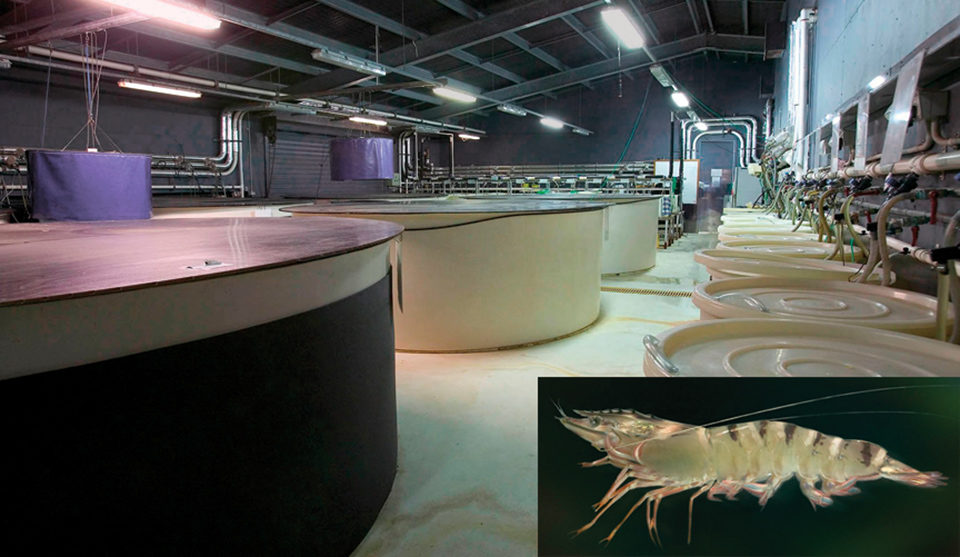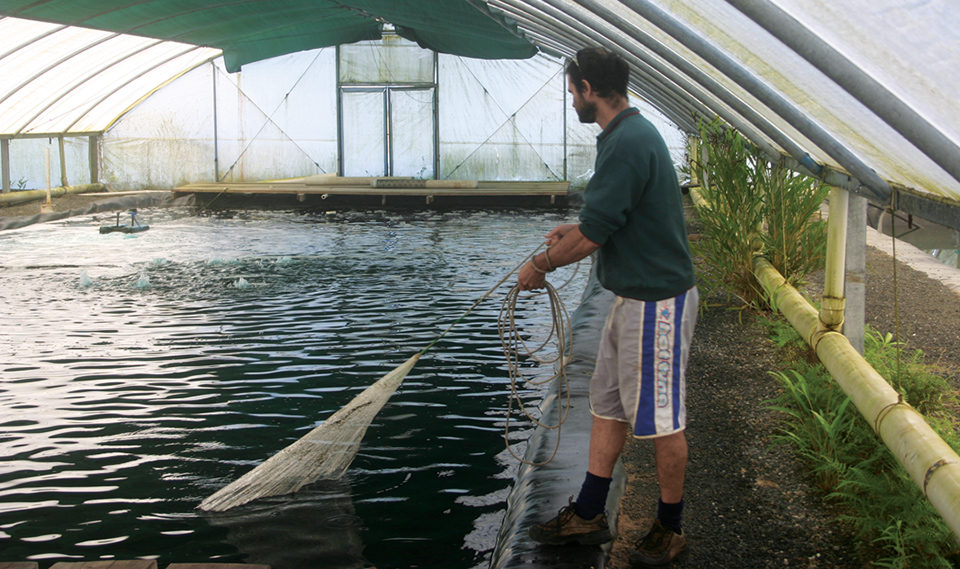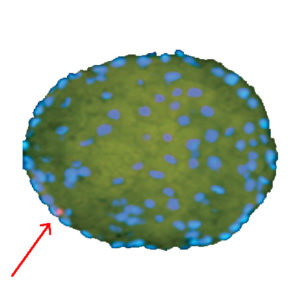Knowledge of biological requirements critical to successful broodstock rearing

Effective biosecurity and health management are arguably the most critical of all biological requirements for successful broodstock rearing. In newly domesticated species, knowledge of the origins and natures of viruses in wild founder populations, subsequent changes in the level of infections in domesticated stocks, and the factors that trigger the progression of infection to disease are vital.
In Australia, molecular screening of wild shrimp stocks has revealed the presence of two viruses that can exist at high prevalence along the northeastern seaboard. Gill-Associated Virus (GAV), closely related to Yellow Head Virus, primarily infects black tiger prawns, (Penaeus monodon). Mourilyian Virus (MoV) has been found in P. monodon; Kuruma prawns, (P. japonicus); and banana prawns, (P. merguiensis).
At the current stage of domestication with P. monodon and P. japonicus in Australia, shrimp reared as broodstock in biosecure, controlled-environment systems have generally been much less at risk from disease induced by these viruses than shrimp sourced from farm ponds to be reared as broodstock. In contrast, pond-reared stocks of P. merguiensis have successfully provided commercially viable broodstock for several years.
Viral transfer – MoV
In commercial trials with P. japonicus, it has proved extremely difficult to keep shrimp sourced from farm ponds alive during rearing to broodstock. To assess the potential involvement of MoV in causing these mortalities, MoV prevalence and infection loads in batches of shrimp reared in tanks were compared to sibling stocks reared in earthen farm ponds for six months before being transferred to controlled-environment maturation tanks.
Molecular screening detected no MoV in any of the batches of 20-day-old postlarvae sampled when the tanks and ponds were stocked. After six months rearing at the start of the maturation phase, MoV remained undetectable in the tank-reared shrimp, but was found in all batches of pond-reared siblings.
After two months in the maturation tanks, overall survival of stocks reared only in tanks remained relatively high at 76 percent, and although MoV was detected in some batches, viral loads were low. In contrast, survival of the siblings originally sourced from farm ponds was just 11 percent, and MoV loads were high in these shrimp.
Persistent GAV infection
In P. monodon, molecular screening has been used to locate wild stocks in Austraila that have been free of GAV and other viruses for which tests are available. However, movement of these wild stocks to commercial and research rearing facilities in a region in which GAV is endemic resulted in them acquiring GAV infection during the initial stage of domestication.
Moderate-level GAV infection persisted in these breeding lines at variable prevalence over successive generations. However, for shrimp reared to broodstock in controlled tanks or raceways, GAV infection passed to seedstock has not impaired their growth, survival, reproductive output, or grow-out performance in commercial ponds.
As observed for MoV in farm-reared P. japonicus, sibling P. monodon stocks grown in farm ponds before transfer to maturation tanks saw high mortalities in association with high-level GAV and MoV infections. Too few shrimp survived to reproductive maturity for breeding lines to be continued from these stocks. Without sibling stocks reared in controlled-environment tanks, this line of P. monodon would have been lost.
For these newly domesticated species, it is yet to be determined if further generations of domestication and associated selection will reduce the risks of using pond-reared stocks as a source of broodstock. In the interim, the use of biosecure facilities appears to be an effective strategy for reducing the risks of viral infections progressing to disease in captive-reared broodstock.

Viral location, transmission
Determining the precise location of viruses in shrimp tissues or organs is important in understanding how infection progresses to cause disease. Recent research at the Australian Institute of Marine Science demonstrated the effectiveness of histology in combination with fluorescent in situ hybridization in locating virus particles in shrimp tissues.
Identifying viral modes of transmission could aid in identifying whether egg washing, with or without virucidal compounds, is an effective means of abrogating the vertical transmission of virus to progeny. Egg washing can only be effective if the virus particles responsible for progeny infection are external to the gametes, for example in the spermatophore, seminal fluid, or ovarian fluids.
To date, there has been no indication of viral infection occurring within eggs either prior to or immediately after spawning. If this finding can be substantiated, washing of newly spawned eggs with common virucidal agents could be effective in reducing or eliminating infections by GAV, MoV, and other viruses passed through successive generations of domesticated breeding lines. See www.oie.int/eng/normes/fmanual/A_00014.htm for the recommendations of the OIE International Aquatic Health Code for washing the eggs of Penaeid prawns.
Broodstock rearing environment, diet

In addition to reducing the risks of stock losses due to viral disease, recent comparisons of different environments for the captive rearing of P. monodon in Australia have demonstrated the benefits of using controlled-environment tanks and raceways to produce mature broodstock within 12 months. This is in synchrony with the annual production cycle of most Australian P. monodon farms.
Moreover, tank-rearing systems have now been refined to obtain 200 percent higher growth rates for domesticated P. monodon females at 11 months of age than those achieved in rearing trials in 1997 and 2000.
The incremental improvement of P. monodon broodstock rearing diets has also led to gains in the reproductive output of domesticated stocks. However, these maturation diets still rely on essential nutrients derived from a variety of natural food organisms, including squid, polychaetes, bivalves, crustaceans, and fish. Moreover, the reproductive out-put achieved with captive-reared P. monodon broodstock remains generally inferior to that of wild-captured broodstock maintained in the same rearing environments and fed the same diets.
Thus, an ongoing challenge for the commercial realization of highly fecund domesticated stocks of this species is to develop a maturation diet that provides all of the nutritional requirements for growth and reproduction. In parallel with meeting this challenge, further research is also needed to develop techniques that optimize the individual and combined influences of nutrition, genetics, health, mating behavior, and environment on the production of superior seedstock from domesticated stocks.
Perspectives
While much of the recent attention on achieving genetic gains in farmed shrimp has focused on the development and application of advanced genetic technologies, the substantial benefits from domestication alone should not be overlooked. These benefits – including the elimination of total reliance on wild stocks, year-round availability of postlarvae, and production of virus-free seedstock – can lead to greater profits for shrimp farmers.
Understanding and managing the basic biological requirements for successful captive rearing of broodstock are of fundamental importance, particularly in newly domesticated species. Once these are achieved, industry can benefit from subsequent cumulative and permanent genetic gains in commercially important traits and associated economic benefits.
(Editor’s Note: This article was originally published in the July/August 2007 print edition of the Global Aquaculture Advocate.)
Now that you've finished reading the article ...
… we hope you’ll consider supporting our mission to document the evolution of the global aquaculture industry and share our vast network of contributors’ expansive knowledge every week.
By becoming a Global Seafood Alliance member, you’re ensuring that all of the pre-competitive work we do through member benefits, resources and events can continue. Individual membership costs just $50 a year. GSA individual and corporate members receive complimentary access to a series of GOAL virtual events beginning in April. Join now.
Not a GSA member? Join us.
Authors
-
Dr. Nigel Preston
CSIRO Food Futures Flagship
P.O. Box 120
Cleveland, Queensland 4163 Australia -
Dr. Greg Coman
CSIRO Food Futures Flagship
P.O. Box 120
Cleveland, Queensland 4163 Australia -
Dr. Jeff Cowley
CSIRO Food Futures Flagship
P.O. Box 120
Cleveland, Queensland 4163 Australia
Tagged With
Related Posts

Health & Welfare
A holistic management approach to EMS
Early Mortality Syndrome has devastated farmed shrimp in Asia and Latin America. With better understanding of the pathogen and the development and improvement of novel strategies, shrimp farmers are now able to better manage the disease.

Intelligence
A motive, and a market, for farmed fish in Mexico
Boasting ample areas for aquaculture and a robust domestic demand for seafood – not to mention its close proximity to the U.S. market – a land of opportunity lies in Mexico. Fish farming is primed to meet its potential south of the border.

Health & Welfare
A study of Zoea-2 Syndrome in hatcheries in India, part 1
Indian shrimp hatcheries have experienced larval mortality in the zoea-2 stage, with molt deterioration and resulting in heavy mortality. Authors investigated the problem holistically.

Health & Welfare
A study of Zoea-2 Syndrome in hatcheries in India, part 2
Indian shrimp hatcheries have experienced larval mortality in the zoea-2 stage, with molt deterioration and resulting in heavy mortality. Authors considered biotic and abiotic factors. Part 2 describes results of their study.


